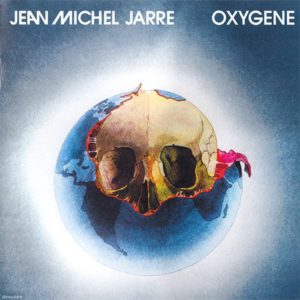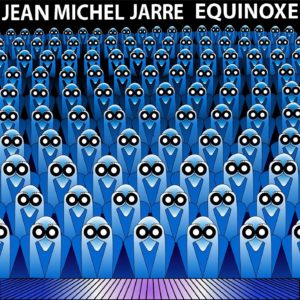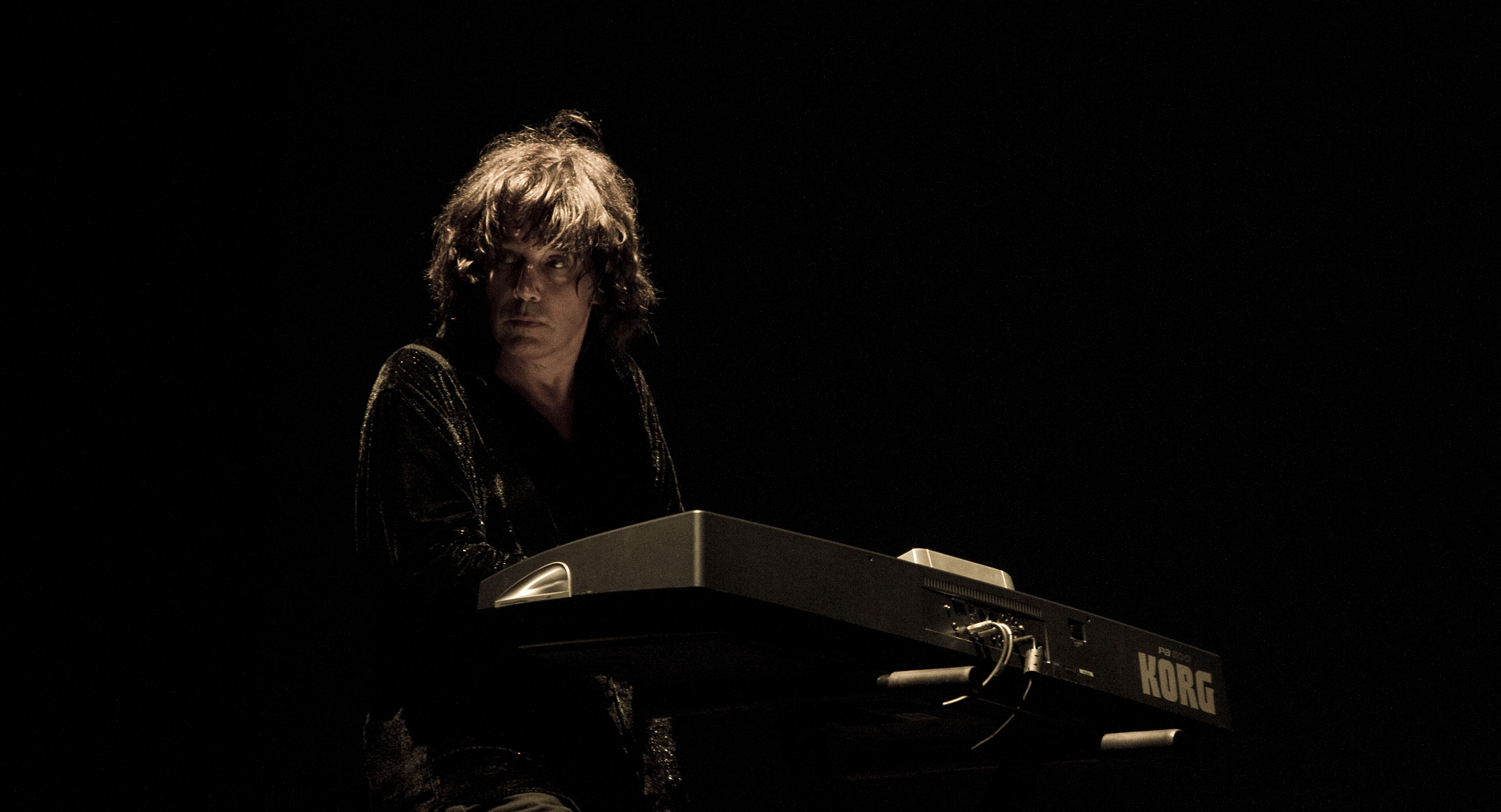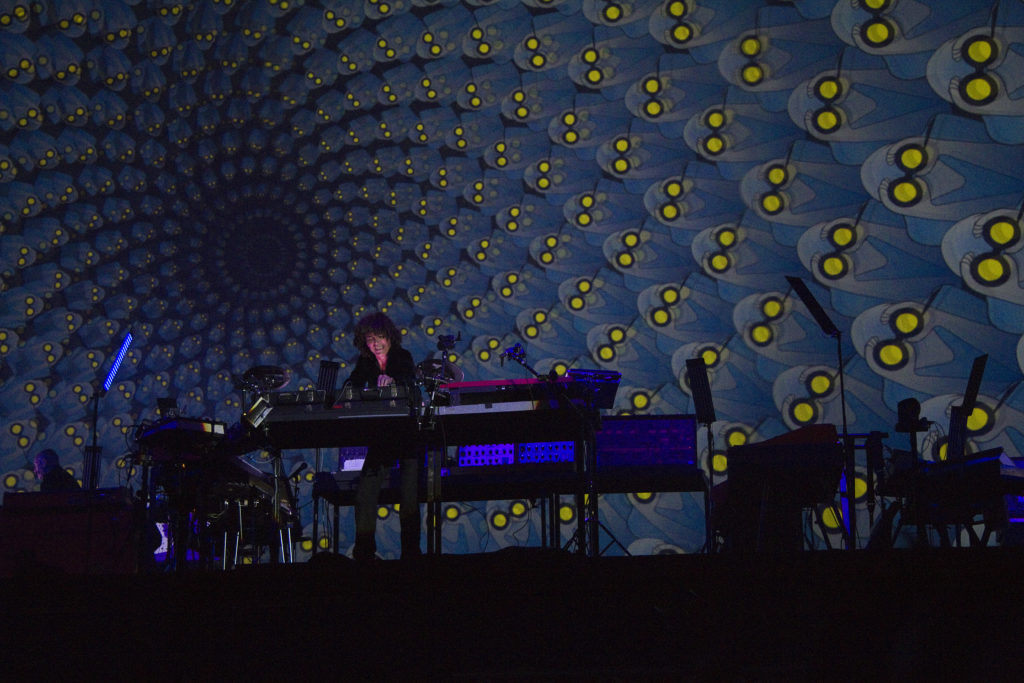Join Jean-Michel Jarre and me as we take a walk through his ENTIRE discography of studio albums, while sitting talking in his flat in Paris. Did you think Oxygene was his first album? Then you are in for a surprise! A fascinating talk with a true innovator, who is now out with a brand new album called Equinoxe Infinity.
This is the first part of a long interview I did with Jean-Michel Jarre in his flat in Paris on November 9th 2018. After handing the story in to the magazine I did it for, I realised that I had so much left over that I really wanted to publish. So here it is! You’re welcome!
It’s a cloudy and a bit chilly day in Paris when Jean-Michel Jarre’s manager Fiona Commins welcomes me into Jarre’s flat. It’s a really nice place, close to the Seine, and even if it’s the size of my own place back in Norway, I think the market value is in another league. Jarre is as usual very friendly and welcoming. Finoa brings me a glass of sparkling water and as we sit down to chat I contemplate on how it’s possible for this guy, who has sold 80 million records, to look so annoyingly young, considering he turned 70 two months ago.
Records and records
The biggest difference from now and when he was at his commercial peak is that these days he is given credit for being one of the biggest pioneers within electronic music.
– If you do this long enough, it goes full circle, he told me the last time I interviewed him.
– But I’m happy I was never in fashion. When you’re not fashionable, you can’t go out of fashion.
Jarre was also the one who started doing the kind of shows that DJ artists are touring festivals with these days. Only on a much grander scale. He used to light up entire city blocks, and it finally ended with him playing in front of 3.5 million people in Moscow in 1997. A world record that still stands.
In the past three years he’s been touring indoors with an innovative light and lasershow, and he even played Coachella this spring. In September he released a big compilation (Planet Jarre) which gave a very good overview of his entire career, which now spans five decades.
Between 2015 and 2016 he released two double albums, Electronica 1 and Electronica 2, where he collaborated with artists like Pet Shop Boys, Moby, Vince Clarke (Depeche Mode og Erasure), Massive Attack, Pete Townshend (The Who), Laurie Anderson, M83, Yello and many more. In addition he also released Oxygene 3, the last sequel to his breakthrough album in 1976.
Deserted Palace
 Yes, I said breakthrough album, because it was actually his third album. Something a lot of people don’t know.
Yes, I said breakthrough album, because it was actually his third album. Something a lot of people don’t know.
– A lot of people think Oxygene (1976) is your first album, but it was really your third. The first one was called Deserted Palace (1972), what can you tell me about it?
– You are right, a lot of people think Oxygene is my first album, for obvious reasons. It was my first successful album. But I started several years before Deserted Palace, but I did other things, like an EP. Interestingly enough, I stared releasing my earliest electronic music a little like DJ’s do today. I started with EPs, and then albums.
– My first EP was La Cage. I did that in the late 60s. I was stealing the keys for the studio at the Music Research Centre in Paris, because we were not allowed to go into this… temple of technology. Only the adult composers at the university were allowed to go there.
– And I started with very limited equipment. I sold my amp, my electric guitar and my electric train, from childhood, to be able to go to London to buy my first synthesizer. The AKS, or the first VCS3, from EMS. Deserted Palace was done in a very minimalist way. The percussion was a little Rototom, which looks a little like a bongo, but it’s encased in metal and you can change the pitch. And all the drums for this album was done on this. And I had to Revox tape machines so that I could copy, do overdubs and re-recordings. So everything on that album was very minimalist.
He finds the album to be interesting and fun.
– I have good memories about making it.
– Was it widely released?
– No, it was only released in America, interestingly enough. It was a request from Fox. In those days electronic music was used by TV and film companies to make futuristic soundtracks for their sci-fi shows, films or whatever.
– I find Bridge of Promises on that album to be especially beautiful.
– Yes, and when I look back on that album today, the titles are quite funny.
– Yeah, Exasperated Frog, for instance.
Jarre laughs and nods.
Les Granges Brûlées
 – Your next album was Les Granges Brûlées (1973), the burning barns.
– Your next album was Les Granges Brûlées (1973), the burning barns.
– Yeah. That was really funny, because it was a total misunderstanding. I don’t think the producer really realised until the release of the album that the music was not really conventional. Because the movie itself is the most conventional French movie you can imagine, with Alain Delon and Simone Signoret. It’s set in Montaigne in France, and it’s a very traditional classic French thriller with a murder in a country house. And then you have this crazy music, which is really experimental.
He says Aphex Twin told him that it was like Aphex Twin music, twenty years before he started his career.
– And the editor, she loved the music. She said it was so fun for her to edit the movie with that contrasting soundtrack on top of it. It worked very well with the movie. But it’s really crazy and strange.
– I’ve never seen it.
– It’s very funny. When I look at it today it’s probably a bit dated and a bit boring, but the music and pictures are in such contrast, that it does create something exciting with the movie.
– I personally really like the main theme.
– Yes, it’s a really strong melody.
– And you also had a human voice singing on it.
– Yes, and we recorded it in my student bedroom. I was still at school. And I had a lousy microphone, it was so bad. And I found a girl with a very nice voice, but even in the recording the voice is slightly distorted, but it works. It creates a kind of mood, I suppose.
Oxygene
 In the following years, Jarre worked with a lot of other artists. He wrote melodies and lyrics, he performed with other artists and produced music for others. He says he did this to get access to the studio technology.
In the following years, Jarre worked with a lot of other artists. He wrote melodies and lyrics, he performed with other artists and produced music for others. He says he did this to get access to the studio technology.
– I looked at the equipment in my bedroom, which was very limited. So professional recording studios became like a holy grail to me. So, to get access I started working with a lot of French pop and rock artists, just to get access to this fantastic technology. I had an idea in my hand to one day use all the experience I gained, and all this technology, to do my own albums.
Having one foot in the avant-garde movement, and one foot in the world of melody and pop, his goal was to create a bridge between these two worlds.
– But if you look back at Deserted Palace and Les Granges Brûlées, I was already attempting to do that. Namely mixing strong melodies with quite crazy experimentations. My more commercially successful music that was to come was a result of all of this.
– In this period, you also did a cover of the old instrumental classic Popcorn.
– Yes. Strangely enough I was asked to do this already before the song had become such a big hit as it eventually became. And since I had to make a living, they approached me and said that “there is this electronic song happening in America, it would be great if we could to the European version of it.” So, I did it.
The experience Jarre gained working in professional studios paid off. In 1976 he felt ready to release his third album, Oxygene (1976). It was an enormous success, and is the biggest selling record by a French artist of all time.
– The hit single from Oxygene, Oxygene Part 4, it’s kind of like Popcorn, with just a few notes missing, isn’t it?
– It’s funny, I never thought about Popcorn when I did Oxygene Part 4. But you’re not the first one to say that. But my song is so different from Popcorn in terms of mood and sound and beat so.. you know, there are several instances in the history of music, where you have certain chords and themes that are close to each other between different songs. When New Wave happened in the late 70s and early 80s, with Human League, OMD, Depeche Mode and all of these bands you can feel the same kind of beats, chords and melodies. But at the same time, they are very different. So, with Popcorn and Oxygene 4, it was really unconscious.
– Andy McCluskey of OMD said that their breakthrough hit, Electricity, was just a speeded up version of Radioactivity by Kraftwerk.
– Really? That’s great! I love that.
– And when he told Kraftwerk, all four of them said, in unison, “we know!”
– Ha ha! I didn’t know that. That’s funny.
– One thing Oxygene is famous for, is the perfect crossfades. The songs just float so well into each other. Did you compose the tracks like that, or did you compose the melodies first, and then decided how to make them crossfade?
– That’s a very interesting point. I agree that the magic of Oxygene is how the different parts are linked together, in quite perfect transitions. I tried to achieve the same thing with my latest album, Equinoxe Infinity.
He says that he composed Oxygene by starting in the middle. Which is a trick he would like to pass on to young musicians.
– If you start in the middle, you have to create the prequel and the sequel to the part you’re working on. You have a track, start in the middle, compose it, and then you construct how you arrived at the middle section, and how you should go on. And that is probably the explanation for the perfect way Oxygene flows together.
– It’s also a bit funny that it does work so well. In the first part you have these very brassy epic moments. First everything is quite cool, and suddenly you have this wild epic..ehh.. fortissimo, or whatever you want to call it. And this came from something completely different, that I had recorded earlier on a tape. And remember, I had just two tapes, I didn’t have the money to buy more. So if I recorded something I wasn’t happy with, I had to erase all of it. But I remember I took the music from one tape that was black, and the other one was pink. So, if you look at the master tape of Oxygene, most of it is black, but suddenly you have this pink section.
Jarre also realises how lucky he was that everything came together as it did.
– In those days you had to physically cut and glue together the tape. And if you had a drum beat, it was very easy to calculate where you had to cut. But when you have more ambient music, it’s much more difficult to cut it without messing up the flow of the music. And you would also hear a click where it was edited. So, I had to add recorded music to mask these edits. But I was able to insert this piece coming from something entirely different, and still make it work as a continuous flow.
– I especially enjoy the transition between Part 1 and Part 2. That’s absolutely magnificent.
– Yes, I agree.
Equinoxe
 – Moving on to Equinoxe (1978). You just had a huge hit album, did you feel any pressure, or did you just go into the studio and work like before?
– Moving on to Equinoxe (1978). You just had a huge hit album, did you feel any pressure, or did you just go into the studio and work like before?
– You know, the first album you do after your breakthrough is always a nightmare, for any artist. Before, nobody is expecting anything from you, and you have no friends. And then you are successful, and suddenly you have lots of friends, and everybody’s watching you.
He then talks about the new album, Equinoxe Infinity, where he has taken the figures with the binoculars from the original Equinoxe cover, used them on the new cover, as well as in all promotional material, and called them The Watchers.
– It’s a perfect metaphor and a perfect cover for your second album, you are being watched, he he.
– When you did Equinoxe, you obviously had a lot more instruments than on the first one.
– Yes, more, but not a lot more, because those days where weren’t that many synthesizers on the market. But I had managed to get my hands on the Yamaha CS-80, probably the best polyphonic (possible to play with more than one finger at a time), analogue synthesizer ever created. I still have it, but it’s a nightmare to get spare parts. But it changed a lot.
It was also the early days of the sequencer, and Jarre had his own revolutionary Matrix sequencer.
– My sound engineer at the time, Michel Geiss, created it for me. I had this idea from my time at the Music Research Centre, where they had this matrix patch with pins. And… you know… what’s really interesting, is that the oscillators and filters we used were not built for musical use. They came from radio stations. Electronic music owes a lot to public radio stations. Stockhausen, Kraftwerk, Tangerine Dream and people like me, we owe them a depth of gratitude. And, of course the BBC Radiophonic workshop, as well as the Research Centre I went to here in Paris.
He then tells me that the first filters and oscillators they used were practically stolen from public radio stations.
– And they weren’t meant for music making, they were there to make sure the sound that went on the air was good! And we stole that from them, to make our music. And in the Music Research Centre, they had a matrix of oscillators, coming from public radio, and one of their engineers made this patch, where he used a matrix of pins. So for us students, going in to such a studio, it was a dream come true.
So, when he started working on Equinoxe, he asked Michel Geiss to conceive a sequencer. It was constructed with 64 rows, which meant 64 notes, and Jarre describes it as a unique instrument, and a major element for how Equinoxe ended up sounding.
– How important was Michell Geiss for your musical development?
– You know, electronic music is of course about technology. And Michel was very important for me, especially in the beginning, because he helped me device and design some instruments. And he also helped me with the technology we had available so that I could make the kind of music I wanted to make.
Among this technology was guitar pedals!
– I used a lot of guitar pedals for phasing and flanging, and at that time, that was the world of guitar players, not keyboardists. It was very strange for people, seeing me going into a guitar shop and buying these for keyboard use.
Of course, the pedals needed to be adapted for keyboard use, because of the difference in signal and electric currents.
– The sound of Oxygene and the sound of the strings on Equinoxe, is based on the Small Stone guitar pedal, and I had to use a small 9V battery. And that was complicated in itself. Because, when the battery was new, the phaser went nuts. And then I found out if the battery was at 7.6 V, it was ideal for 15 minutes. More than 7.6 V, it was too much, and if it went below that, it was too weak. Then Michel, no idea how, managed to connect a device to it so that it would be stable at 7.6 V.
Jarre says that all this fighting with technology, is very symbolic of what electronic music is all about.
– Even these days with computers and soft synths, it’s all about having a very simple and poetic attitude towards technology and technological means, where you hijack and pirate technology, and create accidents. For Oxygene Part 2, for example, the whole structure is based on the fact that I had a broken Mellotron, where only some of the keys worked. And since nobody were using the Mellotron any more, I couldn’t get it fixed. So, the whole track, with the strings, is built around that limitation. It’s the ultimate limitation, which is so important in art. Limitations is the key for everything.
I have to tell you, Equinoxe is my Desert Island Disc. It’s my favourite album of all time.
Jarre clasps his hands together.
– Thank you so much, that’s very nice to hear.
I was 13 when I got it, and one day when I was listening to it in my earphones, the left earphone stopped working. And that’s when I realised how important delay is in your music.
Jarre laughs.
– You know, delay makes 50 percent of the sound of Oxygene and Equinoxe. Basically, I composed in the left speaker, and then I let delay do the rest in the right speakers, ha ha.
– I always picture a rainy day, listening to it. The first notes of the arpeggio are the first rain drops, then the next, then it starts pouring and we end up in a thunderstorm in the last track, which then passes. Was that what you had in mind?
– Yes, I like that you picked up on that with the opening notes being the rain drops. The inspiration of Equinoxe is a mixture of inspiration of the soundtrack to 2001: A Space Odyssey and Fellini movies. It’s a mix of past and future, but also caring about ecology and environment. And Norway was a role model for me there, because you really were ahead of our time there. So, I took a lot of inspiration from the Scandinavian way of thinking about nature.
As mentioned above there are a lot of sounds of rain and water on Equinoxe. But it’s not real.
– You know, I met Fellini, and he said to me that he had always thought he would do a different movie every time he made one. But looking back he realised he always did the same movie. And I think that’s true for everybody. If you take Kraftwerk, OMD, Tarantino, Fellini, U2 or Rolling Stones, we are all doing the same track. It’s just an implementation of the same idea. Talking to you now, I realise that on the new Equinoxe Infinity, is based on the exact same principle. Even the two covers! This mysterious mixture of environment, sounds of nature and technological and electronic sounds.
He says that the biggest difference between the first Equinoxe and the second one is that in the second one, almost none of the nature sounds are real.
– I recreated them with synthesizers, and I this is also inspired by Fellini. He told me that he hated filming the sea. If a scene in the film required the sea, he would recreate his idea of the sea, in the studio. It might be fake, but it would be his idea of the sea. And that sums up what I love about electronic music, you can recreate sounds and do anything.
Stay tuned for Part 2 where we move into the digital era of VHS!
And there’s more. Here is a Spotify playlist that includes several of the songs discussed above:
What did you think of the first part? Any good? Something I should have asked? Leave a comment below!

